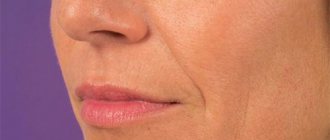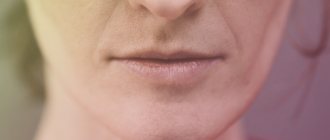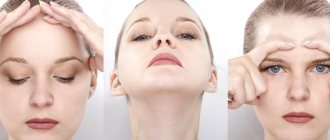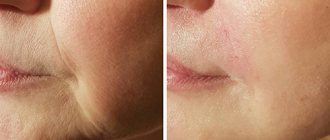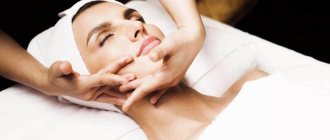From this article you will learn:
- how to remove nasolabial folds,
- reviews, before and after photos,
- side effects and complications.
Having nasolabial folds is normal human anatomy, but these folds can become deeper with age. Deepening of the nasolabial folds occurs primarily due to age-related changes in the skin and subcutaneous fat, gradually leading to gravitational ptosis (drooping) of the soft tissues of the buccal area. Additional influences include exposure to the sun, active facial expressions, and smoking. Patients note that pronounced nasolabial folds give the face a tired look, and ask to make them less noticeable.
The most effective and safe way to make them less noticeable is contouring with fillers based on hyaluronic acid. The method involves injecting a gel based on stabilized hyaluronic acid into the base of the fold. The gel smoothes out the area of soft tissue depression due to the fact that it is able to maintain its volume in the soft tissues for a long time. Depending on the type of filler, the effect can last from 6 to 18 months.
Nasolabial fillers: before and after photos
Correction of nasolabial folds with fillers based on hyaluronic acid is the simplest option for facial contouring, which is not too complicated even for novice cosmetologists. A much more complex correction option is the use of semi-permanent and permanent fillers (for example, based on microspherical particles of calcium hydroxyapatite or particles of poly-L-lactic acid), i.e. drugs such as Radiesse or Sculptra. Working with such fillers will require experience, as well as specialized training in working with such drugs.
But there is a large group of patients in whom correction with fillers will be completely ineffective. Firstly, we are talking about patients with a deformational (edematous) type of aging, who, due to impaired venous outflow and microcirculation, develop increasing interstitial edema of soft tissues (mainly due to subcutaneous fatty tissue). And secondly, in patients with pronounced fat deposits in the cheek area. You can read what to do in these situations below in the “Complicated cases” section.
Correction of nasolabial folds: procedure progress
Before directly starting to inject filler into the nasolabial folds, it is important to decide on the correct treatment strategy, because in this case there are 2 options for correction. The first option is that the filler is injected directly into the area of the nasolabial folds, using one of the injection techniques or a combination of them. The second option is that filler can be injected into the cheekbone area, which will increase their volume and tighten the skin + straighten the nasolabial folds.
In patients with pronounced cheekbones and round cheeks, it is best to actually correct the nasolabial folds themselves, however, in patients with thin cheeks and a small amount of soft tissue, it is better to inject filler into the cheekbone area, because this will give the best aesthetic result. Or a combined correction option is possible, when filler is injected into both the cheekbones and nasolabial folds (the choice of correction option will depend on the severity of the result you expect to see and your budget).
Above, we allowed ourselves to say that this is a fairly simple technique even for novice cosmetologists. This is true if we consider the complexity of correcting nasolabial folds with the correction of other areas of the face. But this relatively simple technique also has subtle points, some of which can make the procedure more effective, while others can lead to complications. Particular attention here should be paid to the upper third of the nasolabial fold, where the angular branch of the facial artery passes, and it is very important not to damage it and avoid embolism (24stoma.ru).
Contraindications to the procedure –
We should not immediately start injecting fillers into the nasolabial folds. At the first stage of communication with the patient, we must assess the medical history and the presence of contraindications to the procedure, after which the patient must fill out an informed consent form for filler injections. There are a number of contraindications for the use of fillers based on hyaluronic acid (including for the correction of nasolabial folds) -
- pregnancy and lactation,
- oncology (even if clinical recovery is achieved - at least 5 years must pass from this moment + permission from the oncologist has been obtained, since there is evidence that injections of hyaluronic acid can contribute to relapse),
- against the background of acute infectious diseases,
- inflammatory processes in the area of intervention,
- autoimmune diseases,
- tendency to form keloid scars,
- if the patient was previously injected with semi-permanent and permanent fillers in this area, or fillers of unknown origin.
In addition, if you have a pathology of the thyroid gland, then this can also be regarded as a relative contraindication. Against the background of this pathology, the destruction of fillers in tissues occurs much faster compared to ordinary patients, and therefore the duration of the effect can be several times shorter. The risk group also includes patients who often use corticosteroid ointments on the skin of the face (they develop granulomas much more often), people who abuse tanning, as well as patients with diabetes.
Choosing a filler for the procedure –
To correct nasolabial folds, denser fillers are used than, for example, to correct superficial wrinkles or to increase lip volume. The final choice will depend on the severity of the nasolabial folds: the deeper they are, the denser the filler with hyaluronic acid should be used. For example, for moderate folds you can use fillers Juvederm Ultra 3, Juvederm Volift, Restylane, Belotero Balance.
For deep folds – Juvederm Ultra 4, Restylane-Perline, Belotero Intense. All of the fillers listed above have FDA recommendations for the correction of nasolabial folds (with the exception of Juvederm Volift, as it is a recently introduced drug). There are a number of cheaper fillers - such as Princess Volume, Hyalax Base and others - that can also be used. However, these fillers are less flexible and behave worse in mobile areas; when used, gel displacement may occur more often.
As for the required volume of filler, usually 1.0 ml of filler is enough to correct moderately severe nasolabial folds (0.5 ml on each side). It is best to choose fillers without lidocaine for correction, because... the latter can lead to temporary whitening of the tissue at the injection site (especially with superficial injection), simulating ischemia, which is a symptom of vascular complications of the injection and requires urgent cessation of the procedure.
However, not only HA-based fillers, but also semi-permanent/permanent fillers can be used to correct nasolabial folds. Their undoubted advantage is their longer-lasting effect, but at the same time, the number of complications after their use reaches, according to various authors, even about 40-50%. Therefore, we still recommend using safer bioresorbable fillers based on hyaluronic acid.
Anesthesia –
If a 13 mm needle is used to correct nasolabial folds, then anesthesia is carried out using a cream or gel containing the anesthetic Lidocaine (the concentration of which in products of different brands varies from approximately 5 to 12%).
The cream is applied to the surface of the skin at the site of intended injection for about 20-25 minutes, after which it is washed off, and the skin is treated several times with antiseptic solutions. If the cannula technique is used, the injection site is numbed with an injection of local anesthetic. This again can be either Lidocaine, or Ultracaine, or some other anesthetics without or with a small content of vasoconstrictor components. Below we will look at the techniques of working with a needle and cannula separately.
Injection techniques (needle) –
In order to remove nasolabial folds, the linear-retrograde technique and its variations are used. For injections, a 13 mm long needle or a long flexible cannula can be used. The use of a needle implies that after injection, the needle moves parallel to the skin in the middle or deep layers of the dermis to the end to its entire length, and the material is removed with a retrograde movement of the needle back. We consider correction of nasolabial folds with a needle to be preferable, because... this anatomical area is relatively safe, and the needle is much easier to control in the tissue.
a) The first version of the classical linear technique implies that the filler is removed along the nasolabial fold, i.e. along it. To do this, needle injections are made at certain intervals of 13 mm to go through the entire length of the nasolabial fold (just short of reaching the wing of the nose, as well as the corner of the mouth). The first injection is made 13 mm from the wing of the nose, and at this moment it is very important to do an aspiration test. Injecting the needle to its full length each subsequent time, we should not immediately begin to remove the material, but first carry out a small separation of the tissues with characteristic movements of the needle (this is necessary for good distribution of the material).
Linear technique for correcting nasolabial folds: video
A complicated version of this technique is a fan technique (Fig. 3), when from one injection point not one linear pass is made with a needle with the material being removed while the needle moves retrogradely backwards, but several passes are made without completely removing the needle from the skin, each time changing its direction . Moreover, each time, remember to separate the tissue a little with a needle before removing the material. Do not forget about the aspiration test to prevent embolism of the angular branch of the facial artery, which runs near the wing of the nose.
b) The second option is to use a linear-retrograde technique in such a way that the material is removed perpendicular to the direction of the nasolabial fold in tracks of 10-12 mm (Fig. 5). First, we stretch the skin with our hands to completely smooth out the nasolabial fold. Next, we make sequential injections, moving in the direction from the wing of the nose to the corner of the mouth, perpendicular to the direction of the nasolabial fold. The material is removed by retrograde movement of the needle; each needle injection takes approximately 0.03 ml of filler, the distance between injections is 1.0-1.5 mm. In total, each nasolabial fold usually requires about 15-20 needle passes.
Important: there are a number of clinical studies comparing the effectiveness and duration of the results of the two above techniques. Moreover, for clarity, in the same patients, the correction was carried out as follows: the nasolabial fold on the left was filled with a linear technique along the direction of the fold, and on the right side, a linear technique with a perpendicular direction of injections was used. Below you can see the results of these techniques in before and after photos of patients (Fig. 5-6). Photos of patients are taken from a clinical study, which can be viewed here.
Please note that the appearance of those nasolabial folds (see Fig. 5-6, after 4 weeks), the correction of which was performed perpendicular to the direction of the fold with injections, is somewhat better than where the classic linear injection technique was used in the direction of the folds. However, the advantages of both techniques can be used simultaneously by using a third correction option.
c) The third option is a combination of the first two techniques. This option first involves a linear passage with a 13 mm needle along the entire length of the nasolabial fold (do not forget about separating the tissues before removing the material), after which we pass perpendicularly several times, leaving the so-called “stiffening ribs” at a distance of 5 mm from each other. Do not forget about the depth of needle insertion, so if the material is removed too superficially, both contouring of the material and its translucency through the skin are possible (Tyndall effect).
Injection techniques (cannula) –
To remove filler into tissue, not only 13 mm long needles can be used, but also long cannulas (have a blunt end). This method has the following advantages: firstly, there is only one injection point on each side, and secondly, there is less risk of damage and embolism to blood vessels. The insertion point for the cannula is near the corner of the mouth. The injection site must be numbed with an injection of local anesthetic.
Next, using a needle, we create a puncture in the skin and the direction of insertion of the cannula, and only after that we insert the cannula into the tissue, moving it to the base of the nasolabial fold at the wing of the nose. Before removing the material, it is advisable to separate the tissues by moving the tip of the cannula. Next, we make several passes (fan technique), removing the material with a retrograde movement of the cannula back. A digital passage of the excretion area is required.
Correction of nasolabial folds with cannulas: video
Radiesse
The German drug contains calcium hydroxyapatite and gel. Radiesse is injected into the deep layers of the dermis. It is not used for superficial injections. Radiesse fills the “voids” under wrinkles, thereby smoothing them out. Gradually, the auxiliary gel dissolves and the main rejuvenating effect is carried out by the active component. Calcium hydroxyapatite stimulates body tissues to synthesize collagen. The more active the production of collagen fibers is, the faster the skin will restore its elasticity and unsightly skin folds will disappear.
Contour plastic using this product is used both for tightening the oval of the face and for the purpose of a general rejuvenating effect. The result will please you for 1 to 3 years.
Contour plastic surgery of nasolabial folds: price
For contour plastic surgery of nasolabial folds, the price in professional dermatological clinics starts from 10,000 rubles (for 2022). The final cost will depend on the brand and volume of filler. For example, the cost of correction when using 1.0 ml of Juvederm Ultra 3 or Ultra 4 will be about 13,000 - 14,000 rubles, Restylane or Perlane - 16,000 rubles.
The cost of services from private cosmetologists is usually somewhat lower, but we immediately draw your attention to the fact that too low prices can only indicate the use of counterfeit drugs, the volume of use of which, according to statistics, already reaches 40% of the total volume of drugs. For example, the cost of the Juvederm Ultra 3 filler alone is about 7,000 rubles, and the Restylane line of drugs ranges from 8,000 to 10,000 rubles. Therefore, if you are offered a final cost of 7000-8000 rubles, then this is only possible if you use counterfeit drugs or fakes.
Complex of Evgenia Baglyk
Preventative exercises for wrinkles at their initial appearance were also developed by face-building trainer Evgenia Baglyk. They restore muscle tone in the cheeks and mouth.
How to do them correctly:
- “Rabbit” is an exercise that imitates the movements of the nose, like an animal. Place your index fingers along the nasolabial folds, fixing them. Move your upper lip without moving your lower lip. Photo reference:
- Look in the mirror and raise your upper lip (like a dog grins), determine the area of the formed folds. Place your fingers on these areas and press them to the skin. Move your upper lip again, as in the photo:
- Looking at yourself in the mirror, move your nose, pulling it down. At the same time, do not work with eyebrows, forehead and lips. If the exercises are easy, you can add resistance in the form of resistance with your index finger (place it on the tip of your nose and resist pulling down).
- Flare your nostrils and relax 10 times.
If you train daily using this method for a month, the wrinkles in the nose area will disappear.
Side effects and complications –
The most dangerous complications that can be encountered during the correction of nasolabial folds with hyaluronic acid fillers are vascular complications. They arise, firstly, due to the introduction of a large amount of filler near the vessel, which can lead to its compression and disruption of blood circulation in this area. Secondly, the vessel may be damaged by a needle (rarely by a thin cannula), which can lead to embolism due to filler entering directly into the lumen of the vessel.
In these cases, ischemia first occurs, accompanied by tissue whitening, which, if no assistance is provided, can progress to tissue necrosis. Whitening of tissues without pain indicates compression of the vessel, and whitening with sharp pain is a symptom of embolism. But in rare cases, tissue whitening can be caused by the presence of the anesthetic lidocaine in the filler, simulating ischemia. Treatment of ischemia and embolism must be urgent and require injections of hyaluronidase.
Examples of some complications -
Another complication is the Tyndall effect, which occurs when fillers that are too dense are injected too superficially. This leads to a change in the refraction of light and the fact that bluish or pinkish stripes begin to appear under the skin at the places where the filler was introduced. If such an effect occurs, it can only be eliminated by dissolving the filler using hyaluronidase injections.
Granulomas are another complication, but they are more common with semi-permanent and permanent fillers than with hyaluronic acid fillers. However, this is also possible when using HA fillers. Granulomas in the form of small bubbles on the surface of the nasolabial folds arise due to the fact that the body reacts to the filler as a foreign body and tries to isolate itself from it using a capsule of granulomatous tissue (granulomas can be either inflammatory or non-inflammatory in nature).
Granulomas often form when fillers contain high levels of residual substances used to stabilize (crosslink) hyaluronic acid molecules. This component includes, for example, BDDE. Its recommended residual concentration in the filler should not exceed 0.9-1.0%, and therefore you should not choose very cheap fillers.
Princess
The drug is made in Austria. The composition includes hyaluronic acid, purified using a special SMART system. Thanks to this treatment, the product becomes homogeneous and is able to be evenly distributed in the voids under the skin. There are several lines of the drug, each of them has its own purposes and indications.
Princess Filler is used for facial skin lifting, in particular bio-reinforcement. Most effective for moderate wrinkles. The series is recommended for young girls.
Princess Volume. A number of preparations for more mature skin of oily and combination types. The line is effective in the fight against deep wrinkles. Princess Volume is also used to correct the shape of the face and helps eliminate traces of acne.
The result lasts 6-12 months.
Complex cases of correction –
In some cases, the volume of overhanging tissue in the cheek area is so large that correction may require a whole bucket of fillers. We have already said above that this happens in two groups of patients, and in particular in the presence of pronounced “fat bags” in the cheek area. In this case, it is optimal to achieve a reduction in adipose tissue using lipolytic injections (approved for use on the face) + plus the parallel use of vascular drainage drugs.
The second group of patients are patients with deformational (edematous) type of aging. Such patients usually always have problems with the spine in the cervical-collar area, and due to prolonged spasm of the muscles in this area, the venous outflow in the soft tissues of the face and neck is disrupted. As a result, microcirculation and lymphatic drainage are disrupted, which lead to the development of interstitial edema, primarily of subcutaneous fat. As a result, the volume and mass of tissue increases, which leads to gravitational ptosis, including in the area of the nasolabial folds.
What to do in this case. In order to fully solve the problem, you need to normalize venous outflow, microcirculation and lymphatic drainage. This is done by conducting a course of capillary mesotherapy/lymphatic drainage vascular injection, which will remove interstitial edema, thereby reducing the volume of soft tissues of the face (including the severity of nasolabial folds). And only after this should the question of the need for further correction of nasolabial folds with fillers be resolved.
But you must understand that only the use of capillary mesotherapy in patients with the edematous type of aging (without correction of problems in the cervical-collar area) will only give a temporary effect. Treatment should include not only periodic courses of therapeutic massage and acupuncture, but even, for example, the correct choice of office chair if you have a sedentary job, is critically important. You can’t even imagine how quickly the wrong chair can lead to problems with the spine, and, as you now understand, even aggravate the aging of the face.
Etermis
German products, which contain two active substances: mannitol and hyaluronate.
Mannitol has antioxidant properties. It slows down the destruction of hyaluron, which further prolongs the preservation of the rejuvenation effect.
Unlike other products, Etermis contains an increased concentration of hyaluronic acid. Accordingly, the drug is more effective and allows you to replenish a larger volume, as well as maintain the result for as long as possible.
Our doctors work with Etermis 4. It is injected into the middle and deeper layers of the dermis. This series successfully copes with deep wrinkles and massive ptosis. Etermis 4 fills voids, replenishing lost volume. Even deep, pronounced folds are smoothed out. Using Etermis 4, a cosmetologist can also correct facial asymmetry and correct lips.
The effect of Etermis lasts up to 2 years.
Exercises for nasolabial folds –
Some people claim that exercise can strengthen the muscles surrounding the nasolabial folds, potentially making them less noticeable. Nevertheless, it is believed that active facial expressions associated with contractions of the facial muscles, on the contrary, lead to a deepening of the nasolabial folds. There are no clinical studies on this issue. The complex for nasolabial folds includes the following exercises, which are recommended to be done every day -
- Pucker your lips while lifting them towards the tip of your nose and hold for 15 seconds (repeat 4-5 times).
- Pucker your lips so they appear fuller, then pull the corners of your mouth outward and hold for 15 seconds (repeat 4-5 times).
- With your mouth slightly open, pull the corners of your mouth with your index fingers, moving them further apart, and hold for 2-3 seconds (repeat 25 times). We hope that our article was useful to you!
Sources:
1.
, 2. Personal experience with fillers, 3. National Library of Medicine (USA), 4. https://aestheticsjournal.com, 5. “Cosmetic dermatology” (L. Bauman), 6. “Anatomy & volumizing injections” (Nabila Azib, Philippe Berros, Frederic Braccini).
The result of using Libriderm patch fillers
The manufacturer promises a quick and visible effect that is cumulative. After using microneedle fillers, you can expect the following results:
- smoothing wrinkles and folds;
- even out skin color;
- reduction of swelling;
- lightening dark circles;
- saturating the skin with moisture, increasing the production of collagen and elastin;
- effect lifting in the orbital area;
- restoration of firmness and elasticity of the dermis;
- improvement of nutrition and metabolic processes in tissues.
Those who have used the product note a real and noticeable effect from the first use. The skin becomes more elastic and fresh, folds are less pronounced.
General recommendations
The best exercises for nasolabial folds are those that are performed regularly. Don't expect instant results after the first weeks of training. The muscles are worked out gradually, the effect also depends on the individual characteristics of the skin.
Tips for implementation:
The intensity of training must be adjusted independently, avoiding overexertion. Be sure to monitor the correct execution using a large mirror. To enhance the results, it is recommended to work out 1 selected complex, supplementing with exercises for the forehead and chin. It is important to monitor your posture, keep your back straight, and do not press your neck. You need to exercise at least 5-6 times a week, enhancing the effect with caring cosmetic procedures.
Rules for performing gymnastics for the face
Careless movements while performing facial exercises can lead to the appearance of unwanted wrinkles and creases, as well as damage to muscle fibers. To avoid common mistakes and not harm your skin, follow the rules:
- Before starting classes, ventilate the room: fresh air will speed up blood circulation, saturate the cells with oxygen, and also give you strength.
- Wash your hands thoroughly and cleanse your face.
- Apply a thick layer of nourishing cream to your eyelids, and a light base oil or cream to the rest of your face.
- Watch your posture and head alignment.
- While tensing the muscles in the mouth area, try to relax the remaining areas.
- Monitor the process using a mirror.
- Make the exercises more difficult gradually.

